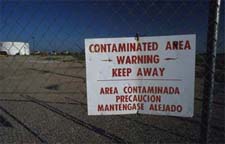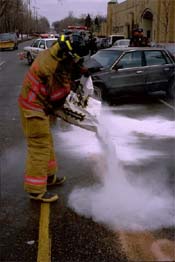 |


|
|
Detoxifying Terrorism
|
|
By Anne Platt McGinn Senior Researcher, Worldwatch Institute
Post September 11th, these facilities are potential sitting ducks for terrorists. Bombing any one of them could disrupt local and national economies, cripple public safety, and spew untold amounts of poisonous chemicals into the environment. Our exposure to potential terrorist attacks on chemical facilities is alarming. But even without any new acts of terrorism, these facilities are already systematically damaging people's health and well-being. In 1999, the latest year for which there are complete figures, the EPA reports that during production and disposal U.S. industrial facilities released 7.7 billion pounds of toxic chemicals into the air and water.
In the aftermath of September 11th, many of these chemical facilities are now under heightened security, as are the nation's transportation systems, military sites, and government properties. Better security is necessary, but in the long-term, our strategy should be to minimize our use of toxic chemicals altogether, and the sooner the better. Innovative companies, business leaders, and public authorities worldwide have proven that many toxic chemicals are simply unnecessary, and that phasing them out with safer substitutes or with redesigned industrial processes saves money, is healthier for workers and the public, and reduces potential domestic targets. Companies from IBM to Motorola have significantly reduced their use of chlorinated solvents in cleaning operations, turning to water-based washes instead. Toy manufacturers have phased out PVC plastic to protect children from absorbing harmful chemical additives known as phthalates. The American Hospital Association has pledged to eliminate all mercury-containing wastes by 2005. Burning these wastes releases potent toxins that damage the nervous system. In a more systematic approach, Massachusetts passed a law in 1989 requiring manufacturers to examine their use of toxic chemicals and prepare reports on alternatives. Although the law says nothing about adopting these alternatives, some 80 percent of companies followed their own advice and reduced toxic inputs by 24 percent, while increasing production at the same time. There is also a booming business in reducing the toxicity of manufacturing by producing goods entirely from renewable resources, rather than the current mix of toxic inputs. In the United States, million tons of industrial and consumer materials-including paints, plastics, and detergents-are now produced from crops, rather than chemicals. Bio-based products now account for more than 30 percent of the U.S. market in adhesives, surface cleaning agents, and additives in plastics. Last year, Dow Chemical and Cargill (an international food and agricultural company) broke ground on the world's first manufacturing facility that will make plastic from corn sugar, rather than petroleum.
 Since September 11th, there have been many suggestions about how to make the country less vulnerable to terrorism. At the very least, funding the research and development of safer alternatives and cleaner manufacturing processes should be an integral part of any plan to reduce our vulnerability to terrorism.
Since September 11th, there have been many suggestions about how to make the country less vulnerable to terrorism. At the very least, funding the research and development of safer alternatives and cleaner manufacturing processes should be an integral part of any plan to reduce our vulnerability to terrorism.
Anne Platt McGinn is a Senior Researcher at the Worldwatch Institute, a Washington DC-based environmental research organization. She is the author of Worldwatch Paper 153, Why Poison Ourselves? A Precautionary Approach to Hazardous Chemicals. |

© 1997-2002 BEI
 Heightened national security concerns have renewed interest in our vulnerability to toxic chemicals, a health threat that has faced Americans for decades. In the U.S., around 850,000 industrial facilities routinely use hazardous and extremely hazardous chemicals, according to the U.S. Environmental Protection Agency, creating a plethora of health and environmental problems even when the facilities are working normally.
Heightened national security concerns have renewed interest in our vulnerability to toxic chemicals, a health threat that has faced Americans for decades. In the U.S., around 850,000 industrial facilities routinely use hazardous and extremely hazardous chemicals, according to the U.S. Environmental Protection Agency, creating a plethora of health and environmental problems even when the facilities are working normally.